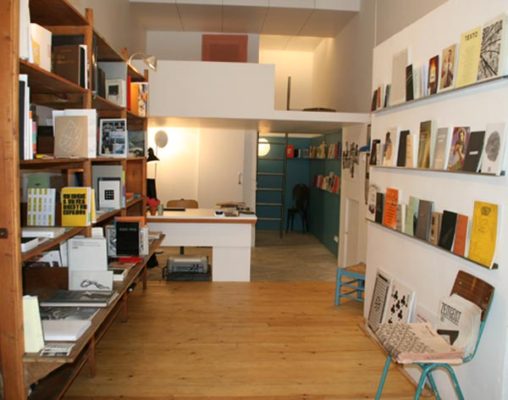Search
To search for an exact match, type the word or phrase you want in quotation marks.
A*DESK has been offering since 2002 contents about criticism and contemporary art. A*DESK has become consolidated thanks to all those who have believed in the project, all those who have followed us, debating, participating and collaborating. Many people have collaborated with A*DESK, and continue to do so. Their efforts, knowledge and belief in the project are what make it grow internationally. At A*DESK we have also generated work for over one hundred professionals in culture, from small collaborations with reviews and classes, to more prolonged and intense collaborations.
At A*DESK we believe in the need for free and universal access to culture and knowledge. We want to carry on being independent, remaining open to more ideas and opinions. If you believe in A*DESK, we need your backing to be able to continue. You can now participate in the project by supporting it. You can choose how much you want to contribute to the project.
You can decide how much you want to bring to the project.

Múltiplos, a bookshop specialising in artist’s books, opens its doors. The creative practice of working on paper continues, and multiplies, embracing what are its origins and undoubtedly what are its aims. Artists who produce books, books that form part of strategies and multiple systems of work, where a series of possibilities of contact appear at the same time.
The artist’s book, at this point in time, might seem like a concession to nostalgia. Amongst the examples that one finds at Múltiplos, the bookshop specialising in this extensive field of publishing, that recently opened in Barcelona, one finds that a certain number do refer to proposals that, aside from being more or less conceptual in origin, make use of graphic and formal solutions that are easily identifiable with North American conceptual art of the end of the sixties. There are also proposals that in a similar way refer to counter-cultural publications of the following decade, that reveal, once again, how their fruition is due more to an aesthetic tendency than a reflection of the anti-establishment spirit that one could find in its genesis. That said, in reference to this collection of publications, often self-published by artists and collectives and which, in any case, are developed according to the logic of creative projects, I think it is opportune to ask ourselves if they really are just publications with a vintage feel, a sort of revival – and if so, one that has already been around for a fair number of years -, or, if one can hope for something more, even today, from so-called “artists books”.
In 1969 –going back to a key moment in this genealogy of cultural production, Seth Siegelaub, shortly after having closed his gallery on West 56th Street in New York and having gone on to produce exhibitions that only existed in paper format, stated that, thanks to the publications, “now my gallery is the world […], pages in catalogues and magazines can be distributed across the whole world, very rapidly”. This reflection upon the mass distribution and direct communication with regard to artistic practices we find formulated in a similar way regarding many other examples of mechanisms that have permitted media experimentation in the art of the 20th century; from the experiments with film by the Russian constructivists to the use of digital formats on the Internet by artists that have arisen since the nineties. Concerning in particular the latter, another statement, which in this case proceeds from the manifesto of the Société Anonyme at the beginning of the new millennium, also raised the idea of the replacement of the apparatus of the exhibition: “In the societies of the 21st century, art won’t be exhibited. It will be produced and distributed”.
Today, however, it is evident that even though artistic practices have a really important presence on the Internet and to all extents and purposes could not subsist without taking into account this network in a large majority of the phases of production and distribution, the same is equally true for publications on paper, as well as exhibitions in galleries or physical spaces, that continue to have as much or more importance than before, quite probably without any of these mechanisms ever having managed to write off any of its predecessors. At the beginning of the 21st century, it is likely that if anything could be diagnosed as obsolete it is none of the media or technologies of communication that have been gestated in the last century, but what should probably be definitively dismissed from culture would be this brand of Darwinian rhetoric, that so often appears linked to the emerging processes of technological innovation. So, with regard to artists books, what one can see today is that not only have they not been supplanted, but that, they take into account on the one hand the most recent discoveries of digital technologies and on the other the survival of exhibition spaces, and what we find is precisely how they redefine themselves and transform their modus operandi, in parallel with the constant redefinition of the media landscapes into which they are embedded at every moment.
Anna Pahissa, the director of Múltiplos, states within the framework of her first public activity that the bookshop is only the first step of an initiative of a much greater dimension, and that consequently she prefers to define the new initiative as “a platform”. Amongst the objectives, that Anna highlights is that of functioning as a structure for distribution, contributing as much to the dissemination of national publications as to the distribution of imports here, at the same time as she talks of the desire to intervene in the production of new publications, be it by establishing collaborations with other organisations or through the articulation of her own editorial line. And finally she also aims for it to function as a space for research, with the organisation of analytical and critical debates and other initiatives. All in all one could interpret it simply as the desire to make the business grow, although I think that the potential that she mentions also bears equal witness to the vitality that these sorts of publications are enjoying –in accord with the possible trend or revival that one deems to be occurring – as well as, and probably in a more interesting way, reflecting some of the particularities that are currently occurring within the development of publications linked to artistic projects.
Given the texture of the book, its condition as a signifier and its dimensions as an object, this vehicle is likely to instil a certain sense of dejà-vu, that of a return or a repetition of the past. And this significance would also in some way correspond with the boom that is also occurring amongst artistic practices based on certain mechanisms of remembrance and history that have led to the recuperation of elements, also previously widely employed within conceptual practices, such as the archive or the document. At the same time, however, solely in considering this evocation and exploration of the potential of nostalgia, there exists the risk of re-establishing – that however extensive it may be still remains a huge paradox – the quality of fetishism that the conceptual genealogy of art precisely tried to refute with the practice of the book.
On the other hand, when considering the book as a mode of communication and its value in relation to a media environment that has become progressively more complex, it is still possible to activate its potential in relation to the multi-media solutions current in artistic projects at the moment. In this sense, we should not consider the artist’s book solely in relation to the media scenario of the period of conceptual art, where it tended to be used as an alternative, be it to capitalize on its artistic value or to substitute other forms of representation such as the exhibition or the catalogue. With regard to the current media landscape, I think that the use of printed material in relation to artistic projects is proposed more as a series of mechanisms that no longer function in a centripetal way, and that instead activate a selection of available elements, in articulation with other media.
In this sense, the printed publication assumes a strategic role in order to expand the declared performing possibilities of artistic practice, with the aim of generating meanings and situations, in the middle of a more complex itinerary that the projects in question trace by way of different media supports, as well as the possible activation, in the case of the book, of cultural, narrative and contextual patterns that are associated with it as experimental resources.
It is possible that were it just a nostalgia trip, it would be enough for Múltiplos to be simply a bookshop or a curiosity shop. However in relation to the multiplicity of functions and capacity to intervention that artists books assume, even today it requires on the other hand; connectivity as well as the will to create hybrids and to work in collaboration. The bookshop appears in this way as a node to be rearticulated according to the logic of specific projects, probably a tool at the service of producers and cultural agents. Just as the very term “Múltiplos” alludes to the serialisation that is typical of the printed support, it could also come to refer to its activity as a “platform”, to the effect of multiplication and exponential development that cultural and artistic processes can propose with the strategic use of and at times unpredictable connection between media supports; of the most up to date as well as the more antique.

Oriol Fontdevila thinks that the political and social dimensions of art practices and cultural phenomena are interesting; that the question of cultural innovation ought to be dealt in correlation with that of social progress: that cross-disciplinary working is an opportunity, not just to accumulate knowledge, but to generate surroundings from where to challenge them; and that art criticism and curating can contribute in this respect.
"A desk is a dangerous place from which to watch the world" (John Le Carré)